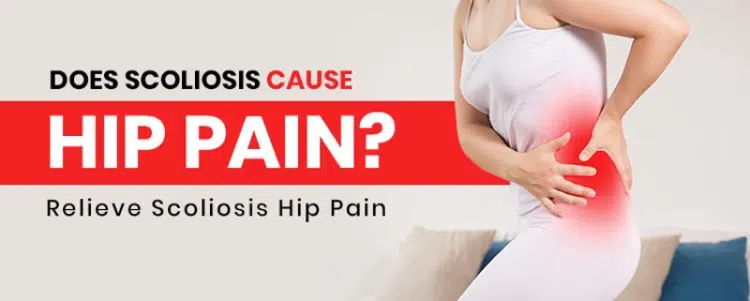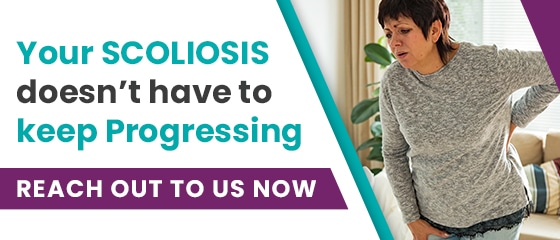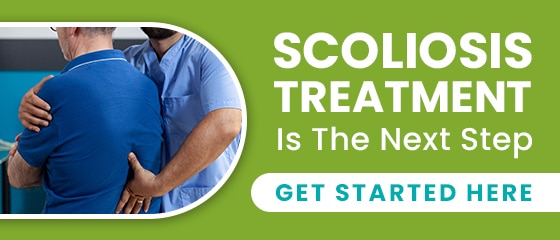As an abnormal sideways spinal curvature, with rotation, scoliosis can cause a lot of changes in the body. While every condition is unique based on a number of variables such as patient age and condition severity, there are some fairly common scoliosis symptoms, one of which is scoliosis hip pain.
Scoliosis is a highly prevalent spinal condition with the potential to produce a wide range of symptoms. While common scoliosis symptoms differ based on whether we are talking about adolescent or adult patients, postural changes and scoliosis hip pain are among those commonly described.
Before we move on to the specific causes and treatment for scoliosis hip pain, let’s start by exploring what is happening inside the body of a person with scoliosis.
Understanding Scoliosis
When a person is diagnosed with scoliosis, this means a few things. It means they have an abnormally-curved spine that includes rotation and a minimum Cobb angle measurement of 10 degrees.
A patient’s Cobb angle refers to a measurement obtained via X-ray that draws intersecting lines from the tops and bottoms of the most-tilted vertebrae (bones of the spine) in the curvature; the resulting angle is measured in degrees.
Cobb angle is the standard for scoliosis assessment as it places the condition on its severity spectrum of mild, moderate, severe, or very severe.
- Mild scoliosis: Cobb angle measurement of between 10 and 25 degrees
- Moderate scoliosis: Cobb angle measurement of between 25 and 40 degrees
- Severe scoliosis: Cobb angle measurement of 40+ degrees
- Very-severe scoliosis: Cobb angle measurement of 80+ degrees
While there are other important factors that help determine what types of scoliosis symptoms a person can expect to develop, such as age, generally speaking, the higher a person’s Cobb angle, the more likely their condition is to produce noticeable symptoms and cause related pain.
Another important aspect of understanding the changes a person’s scoliosis can cause is related to the condition’s progressive nature.
Scoliosis Progression
When a condition is classified as ‘progressive’, this means that it’s in its nature to get worse over time. Scoliosis is also incurable, meaning once a person develops structural scoliosis, it is a condition they will have for life; however, that doesn’t mean it’s a condition that can’t be managed and treated effectively.
While there are different types of scoliosis a person can develop, all forms are progressive and will get worse at some point, if left untreated.
As mentioned, the age of a patient is an important factor in predicting symptoms they are likely to experience, as well as their progressive rate. We know that growth is the condition’s number-one trigger for progression, so you can see how age becomes an important variable.
Children and adolescents with the most growth yet to go through are at the highest risk for rapid-phase progression, while adults, who have reached skeletal maturity, tend to progress slower, until about the age of 50 when age-related spinal degeneration can speed up progression.
So in the body of a person with scoliosis, their abnormal spinal curvature is going to increase in size, at varying rates, if left untreated. As a condition progresses in severity, the potential for it to start producing more noticeable symptoms and functional deficits also increases.
Common Scoliosis Symptoms
As mentioned earlier, scoliosis cases are as unique as the patients themselves. Depending on age, condition cause, curvature location, and condition severity, scoliosis is known to produce a wide range of symptoms.
As the condition is most commonly diagnosed in adolescents between the ages of 10 and 18, in the form of adolescent idiopathic scoliosis (AIS), let’s start our discussion of scoliosis symptoms here.
Adolescent Idiopathic Scoliosis Symptoms
Adolescent idiopathic scoliosis is by far the condition’s most common form, accounting for 80 percent of known diagnosed scoliosis cases. ‘Idiopathic’ means there is no known cause, so in the majority of scoliosis cases, we simply don’t know why patients developed the condition.
The remaining 20 percent of known diagnosed cases have known causes: congenital, neuromuscular, degenerative, and traumatic.
In AIS, the main signs and symptoms for parents, and young people, to watch for involve an overall asymmetry to the body:
- Ribs protruding more on one side
- Ribs that protrude during a forward-bend position
- Unevenness during motion
- Arms that are held tightly to the sides while walking
- One hip that is more prominent than the other
- Head appearing uncentered over the torso
- One shoulder/shoulder blade protruding more prominently on one side
- One leg appearing longer than the other
- Ill-fitting clothing
- Appearance of a tilted eye line
- A spinal curvature that is visible to the naked eye
You might be surprised that this list of common AIS signs and symptoms doesn’t include any related to pain; this is because most AIS patients don’t experience pain, although some do. This is due to growth and does not reflect the average adult experience of life with the condition.
Common Symptoms of Adult Scoliosis
As mentioned, age is an important determining factor when it comes to likely scoliosis symptoms a person will experience, especially when it comes to pain.
In children and adolescents, scoliosis is not known to be painful; this is due to growth. When a person is still growing, their spine is constantly experiencing a lengthening motion, and that lengthening motion counteracts the compression caused by an abnormal spinal curvature.
As it’s compression of the spine and its surrounding vessels, muscles, and nerves that causes pain, when growth is counteracting that, the condition isn’t known as painful. Once a patient reaches skeletal maturity, the spine has settled due to gravity, leading to spinal compression and pain.
In fact, when it comes to scoliosis in adults, it’s pain and how to relieve that pain that most commonly brings them in for an official diagnosis. The following are the most common symptoms of scoliosis in adults:
- A pronounced lean to one side
- Uneven shoulder height
- Presence of a rib arch
- Uneven hips
- Back/radiating pain into the legs and feet
So while pain is not a significant part of the adolescent experience of scoliosis, it can become one of the defining features of life with the condition as an adult. In addition to back pain, the condition can cause pain in other areas of the body such as the hips.
Hip Pain and Scoliosis
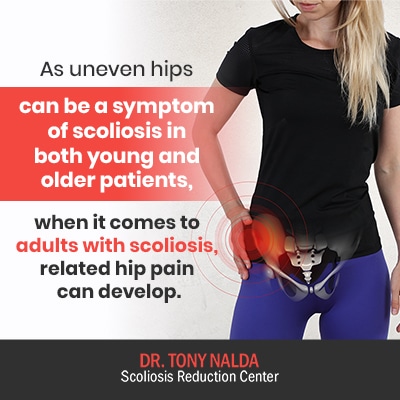
As uneven hips can be a symptom of scoliosis in both young and older patients, when it comes to adults with scoliosis, related hip pain can develop.
The uneven posture that scoliosis is known to cause can lead to pain in multiple areas of the body, especially for adults, and especially when it comes to standing for long periods of time or taking part in certain physically-demanding activities.
Hip pain can develop due to stretched ligaments caused by the spine’s unnatural curvature. In addition, when the curvature causes the pelvis to become tilted, one hip can end up taking on more weight than the other, and this can lead to uneven use of tendons and supportive muscles, causing pain.
The hip pain caused by scoliosis generally develops due to the uneven straining of the iliolumbar and sacroiliac ligaments; these ligaments are tough bands of connective tissue that help stabilize and support the lumbosacral spine where it meets the pelvis. This kind of pain is called ‘sacroiliac joint pain’ (SIJ pain).
Hip pain also evolves out of pelvic dysfunction due to related changes in gait; disruptions in natural movement patterns cause uneven wear and tear on parts and systems that are engaged during movement, such as the spine, pelvis, and hips.
In addition, all forms of movement involve muscles and fascia. ‘Fascia’ is a casing of connective tissue that covers organs, blood vessels, bones, nerve fibers, and muscles. The fascia holds what it’s surrounding in place, providing internal structure.
When a fascial restriction occurs, this means the affected area becomes tight and rigid, due to a combination of stress and unnatural changes in movement. This can also lead to hip pain as the adverse tension caused by the scoliosis affects the spine and pelvis.
So does scoliosis cause hip pain? Yes, it can. However, it is far more likely to cause hip pain in adults as they are no longer growing and are vulnerable to the compressive force of the abnormal spinal curvature.
Relief for Scoliosis Hip Pain
Here at the Scoliosis Reduction Center®, we believe in treating the underlying condition, first and foremost, and not just its symptoms. This can seem obvious, but there is an important distinction to be made between treating a condition, or merely its symptoms.
In fact, in general medicine, it’s not uncommon for more attention to be paid to addressing a condition’s symptoms, than treating their underlying cause: the condition itself. This is evident in how often pain prescriptions are written out to address pain, yet this does nothing to address the cause of the pain.
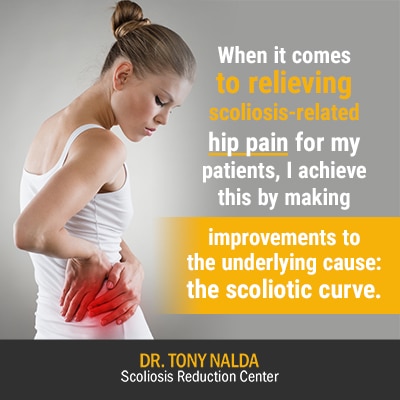
When it comes to relieving scoliosis-related hip pain for my patients, I achieve this by making improvements to the underlying cause: the scoliotic curve. First and foremost, we work towards impacting the condition on a structural level in the form of a curvature reduction.
Next, we work towards strengthening the muscles that help support the spine, and this includes the muscles surrounding the pelvis and hips. Once core strength is increased, and an exercise plan is designed to counteract uneven muscle use and loosen tight muscles, this addresses the underlying cause of hip pain as the uneven postural changes are being addressed and reduced.
As an abnormal curvature is reduced through an integrative chiropractic-centered approach that includes chiropractic care, in-office therapy, and custom-prescribed home exercises, related symptoms such as hip pain are lessened/eliminated as the underlying cause is being addressed.
Conclusion
Scoliosis can produce a myriad of symptoms felt throughout the body. While pain is not commonly part of the adolescent experience of life with the condition, it is often the main complaint of adults living with the condition.
In addition to back pain and pain that radiates into the legs and feet, hip pain is also a common scoliosis-related complaint. This can develop due to the pelvic tilt that can happen as the abnormal spinal curvature distorts the position of the pelvis, causing one hip to sit higher than the other.
As one hip takes on more weight and is exposed to the adverse tension introduced by the unnatural curvature, this can cause the ligaments and muscles that support the spine and pelvis to become strained and tight.
As scoliosis is known to change the way a person moves, this can also lead to pelvic dysfunction and related pain.
When it comes to the best way to remedy scoliosis-related hip pain, our response here at the Scoliosis Reduction Center® is, first and foremost, to address/impact the pain’s underlying cause, which is the scoliotic curve, on a structural level.
As we work towards reducing the unnatural spinal curvature and restoring as much of the spine’s healthy curves as possible, we are improving the spine’s biomechanics and reducing the adverse tension and uneven forces that the body, and its parts, are exposed to.
It’s never too late to seek out proactive treatment for your scoliosis, regardless of age or condition severity. If you are looking for a sustainable remedy for scoliosis-related hip that actually addresses its underlying cause, think ‘correction’, ‘function’, and ‘proactive treatment’, all of which we proudly provide here at the Center.
